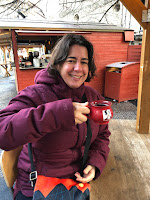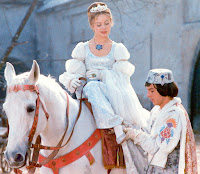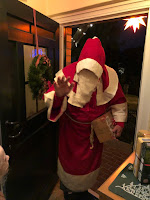
This was a milestone because it was my first actual play in Brno. Every other show has either been a concert, an opera or a ballet.

An American expat adventure in Brno, Czech Republic.

This was a milestone because it was my first actual play in Brno. Every other show has either been a concert, an opera or a ballet.


 |
| Alfred Stiassný |
Alfred Stiassný was a prominent textile manufacturer in Brno. He and his wife, Hermine, owned a number of villas and tenement houses in the city when they commissioned architect Ernst Wiesner to design their new home. Construction took two years and it was completed in 1929.

The family was sporty so the sloping garden had a tennis court and a swimming pool.






Šťastný nový rok! Frohes neues Jahr! Godt nytår! Head uut aastat! Yangi yilingiz bilan! С новым годом! Guten Rutsch! Bliadhna Mhath Ùr! Felice anno nuovo! Selamat tahun Baru! Gott nytt år! Athbhliain faoi mhaise daoibh! ¡Feliz año nuevo! Laimingų Naujųjų metų! Laimīgu Jauno gadu! 新年快樂! புத்தாண்டு வாழ்த்துக்கள்! 新年快乐!
 2020 is a leap-year, with 1 January falling on a Wednesday, which means that we will get 11 public holidays. 11 of 13 public holidays is the most public holidays that can be because if public holidays fall on a weekend you lose them.
2020 is a leap-year, with 1 January falling on a Wednesday, which means that we will get 11 public holidays. 11 of 13 public holidays is the most public holidays that can be because if public holidays fall on a weekend you lose them.
With the way that the days fall we will have six long weekends. I've already got a number of trips already planned including a February trip to Geneva to visit Natalie. In May I'm headed to the USA for a few weeks to see my niece graduate high school. It's going to be a busy travel year with trips to Slovakia, North Macedonia, Sweden, Finland, the Åland Islands, Ukraine, Hungary, Romania, Bosnia & Herzegovina, Austria, Germany, France, Russia, Latvia, Moldova, Poland, Vietnam, and Cambodia.
#20countriesin2020

 |
| The godparents at the cathedral |
We hung out at Alexanderplatz, went over to Nikolaiviertel for a Feuerzangenbowle, and had some hot mulled wine and snacks at the Christmas Market at Gendarmenmarkt.
 It also meant watching Drei Haselnüsse für Aschenbrödel a couple of days in a row. In Czechland it's Popelka. It's a cute film but only for Tünde am I watching this two days in a row.
It also meant watching Drei Haselnüsse für Aschenbrödel a couple of days in a row. In Czechland it's Popelka. It's a cute film but only for Tünde am I watching this two days in a row.


Tomorrow morning Nat and I are catching an early train to Brno so I'll have a house guest for a couple of days. It will be nice to have the Kiwi back in Brno.



It was in Schöneberg which is the city's gay neighbourhood. The market was very small, and there was a lot of pink, but it was interesting.




We've got a couple of more days in Berlin and then Nat and I will go to Brno to spend New Year's in Czechland.
Here are the 10 study questions for the Czech Citizenship exam from section 23: International Background.
 1. What is the name of the international military organisation that ensures the security of the Czech Republic?
1. What is the name of the international military organisation that ensures the security of the Czech Republic?
NATO.
 3. In 2004, the countries of the so-called Visegrad Group joined the European Union. Which four states make up this group?
3. In 2004, the countries of the so-called Visegrad Group joined the European Union. Which four states make up this group?
Czechia, Slovakia, Hungary, Poland.
Strasbourg.
5. In 2007, Czechia joined the Schengen area. To which of the following countries can a Czech citizen travel without border control?
To Germany.
 6. Mrs. Novotná is a citizen of the Czech Republic and travels with her family on holiday to Slovakia. Slovakia, like the Czech Republic, is a member of the Schengen area. What documents will she need?
6. Mrs. Novotná is a citizen of the Czech Republic and travels with her family on holiday to Slovakia. Slovakia, like the Czech Republic, is a member of the Schengen area. What documents will she need?
Passport or identity card.
 7. In 2004, the Czech Republic joined the European Union. What can a Czech citizen do since then?
7. In 2004, the Czech Republic joined the European Union. What can a Czech citizen do since then?
Work and do business in the countries of the European Union.
 8. The European Commission is the executive body of the European Union and manages its policy. How many representatives does Czechia have in the European Commission?
8. The European Commission is the executive body of the European Union and manages its policy. How many representatives does Czechia have in the European Commission?
1.
9. The Czech Republic is a member of NATO. Which city is the seat of this organisation?
Brussels.
10. To which of the following countries can a Czech citizen not travel to with only an identity card?
To Russia.
Here are the 10 study questions for the Czech Citizenship exam from section 22: Socioeconomic Background.
 1. In which region is the Temelín nuclear power plant?
1. In which region is the Temelín nuclear power plant?
In the South Bohemia Region.
Prague and Brno.
 3. What is the name of the famous Czech company that makes pianos?
3. What is the name of the famous Czech company that makes pianos?
Petrof.
Around the town of Žatec.
7. Which of these materials is mined in the Czech Republic?
Brown coal.
8. Which power plants produce the most electricity in the Czech Republic?
Coal.
Škoda.
In Karlovy Vary.
Here are the 10 study questions for the Czech Citizenship exam from section 21: Sociocultural Background.
 1. Approximately how many inhabitants does the Czech Republic have?
1. Approximately how many inhabitants does the Czech Republic have?
10,6 million.
2. A national minority is a group of citizens of the Czech Republic who declare themselves to be of a nationality than than Czech. Who is the largest national minority in the Czech Republic.
Slovaks.*
 3. The Haná cultural region is an important agricultural area and is known for its folk customs. Which regional city is the centre of the Haná cultural region?
3. The Haná cultural region is an important agricultural area and is known for its folk customs. Which regional city is the centre of the Haná cultural region?
Český rozhlas - Czech Radio
5. How many inhabitants does the capital city of Prague have?
Approximately 1 300 000.
 6. In which of these regions of the Czech Republic is currently the highest percentage of unemployed?
6. In which of these regions of the Czech Republic is currently the highest percentage of unemployed?
In the Moravia-Silesian Region.
7. Which religion is most widespread in the Czech Republic?
Christianity.
 8. In which city in the Czech Republic, after Prague, has the largest population?
8. In which city in the Czech Republic, after Prague, has the largest population?
Brno.
Women have the same rights as men.
 10. What is the name of the largest city in Moravia?
10. What is the name of the largest city in Moravia?
Brno.
*Slovaks have been the largest national minority in Czechland. Recently Ukrainians outnumbered Slovaks but for the exam the answer is still "Slovaks."





